Pralay weapon system being displayed during the 76th Republic Day parade celebration at Kartavya Path in New Delhi on January 26, 2025.
| Photo Credit: Shiv Kumar Pushpakar
The missile systems showcased on Kartavya Path during this year’s Republic Day parade capture the evolving long-range tactical strike options for the Indian military, especially the Army, the need for which is one of the key lessons from the war in Ukraine. BrahMos supersonic cruise missiles, upgraded Pinaka Multi-Rocket Launch System (MRLS) with a range of 75 km, BM-21 Grad, which is a 122mm MRLS, and Pralay quasi-ballistic missile system are among those showcased. The Defence Research and Development Organisation (DRDO) also showcased a model of the indigenous Advanced Towed Artillery Gun System (ATAGS) on its tableau.

In addition to Pralay, Army’s new Battlefield Surveillance System, Sanjay, was also at the parade for the first time. Sanjay has been jointly developed by the Indian Army and Bharat Electronics Limited at a cost of ₹2,402 crore, and the systems will be inducted in all operational brigades, divisions and corps of the Army in three phases between March and October this year.
As one of the most advanced rocket systems globally, the fully automated 214 mm Pinaka MLRS battery can deliver a salvo of 72 rockets on the target up to 75 km in 44 seconds, the commentary booklet distributed at the parade on Sunday said. The Army has four Pinaka regiments in service and six more are on order.
Twin-launched Pralay
The Pralay with a twin launcher system showcased at the parade is a quasi-ballistic missile and India’s first ballistic missile designated for conventional role. Development trials of Pralay are over and the development is now complete, as reported by The Hindu earlier. The Defence Acquisition Council has already accorded Acceptance of Necessity for a few hundred of the missiles for the Army and the Air Force. “In threat scenario, Pralay is capable of destruction of war waging potential of adversary even before the commencement of contact battle owing to its flexible range and lethality with different types & class of warheads,” the booklet stated.
In Pictures: India celebrates 76th Republic Day
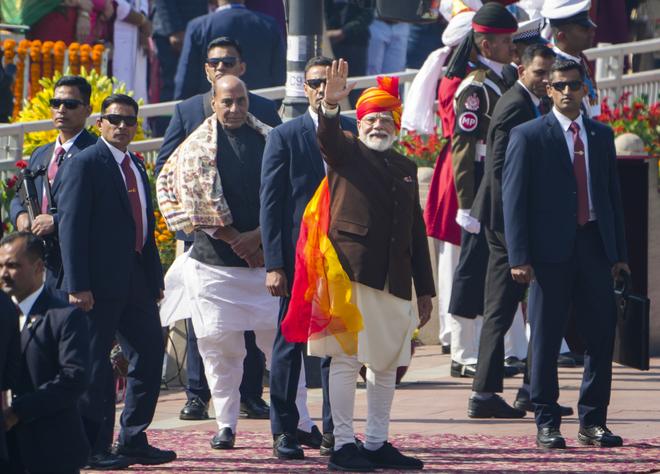
Prime Minister Narendra Modi waves as he leaves after attending the Republic Day parade at Kartavya Path.
India’s Border Security Force’s (BSF) daredevil team performs during the Republic Day parade.
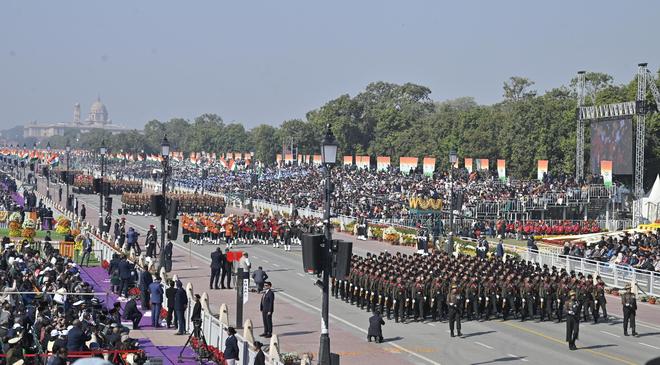
A contingent of soldiers marching at Kartavya Path during the 76th Republic day parade celebrates in New Delhi.

The first aerial formation of the day, the ‘Dhwaj Formation’, proudly carried the National Ensign along with the respective service ensigns of the Army, Navy, and Air Force.
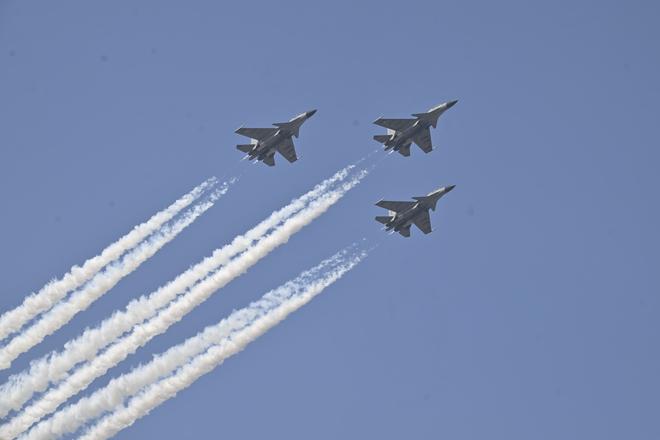
IAF performed variety of formations including Dhwaj, Ajay, Satluj, Rakshak, Arjan, Netra, Bheem, Amrit, Vajrang, Trishul and Vijay. The concluding Vertical Charlie manoeuvre was performed by a Rafale fighter aircraft.
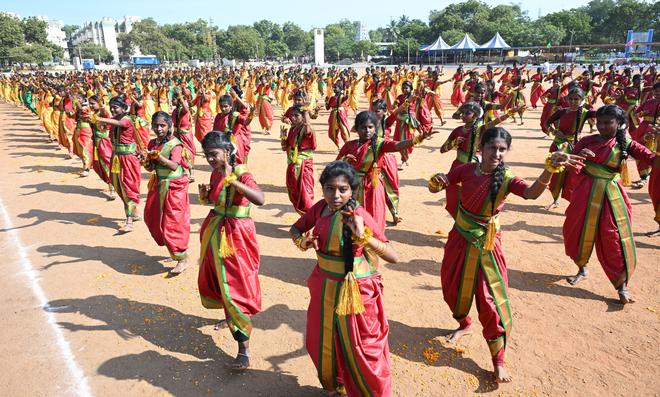
School students perform dance during Republic day celebration at Armed Reserve Police ground in Madurai.
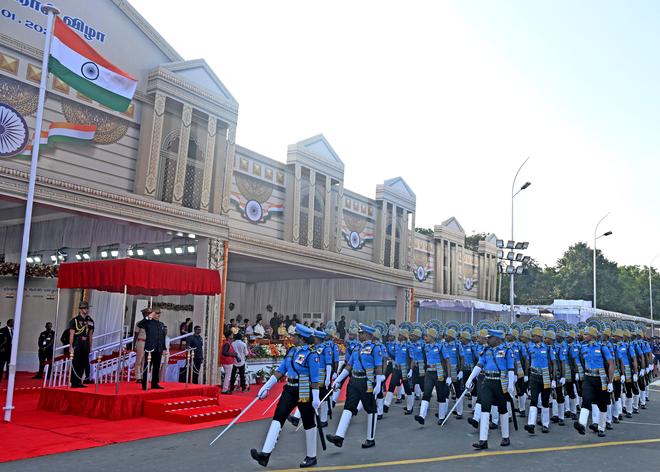
The Tamil Nadu Governor R.N. Ravi takes the salute of the parade held at Kamarajar Salai in Chennai.
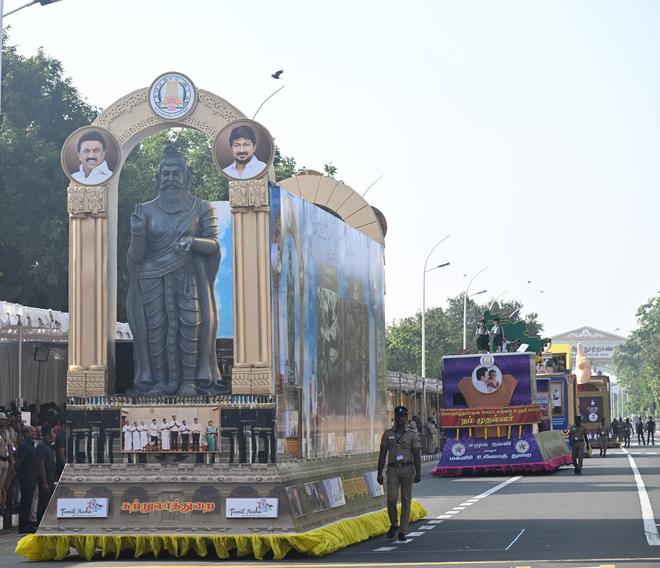
Decorated government department tableaux rolling down on Kamarajar Salai during the 76th Republic Day celebration in Chennai.
Group of students march at the Bakshi Stadium in Srinagar.
Students perform during Republic Day celebration in Bakshi Stadium Srinagar.
Deputy Chief Minister of J&K Surinder Kumar Choudhary inspect parade Republic Day in Bakshi Stadium Srinagar, Sunday 26 January 2024.
An ABVP activist, waves national flag Republic Day celebration at Lal Chowk in Srinagar, on January 26, 2025.
1/3
The upgraded Pinaka is going to be the mainstay of the Army’s long-range rocket artillery. Last November, the DRDO announced the successful completion of flight tests of guided Pinaka rockets of 75-km range, paving the way for its induction by doubling the original range of 37 km. Work is on to enhance the range to 120 km and further to 300 km.

Last September, the Army’s Director General of Artillery Lt. Gen. Adosh Kumar said that the Pinaka system is being widely exploited and their ability is second to none. “We are looking at extending the range of the Pinaka rockets and a lot of work is going on, first to double and then to almost four times of the present range. The DRDO is confident of achieving it.”
In addition to Pinaka, the Army has five Grad rocket regiments and three Smerch regiments with a range of 90 km. Another missile, Nirbhay sub-sonic cruise missile, the longest range option, is in an advanced stage of development trials and can be expected to be showcased on Kartavya Path in the next few years.
Specialised ammunition in Pinaka
Another aspect adding to the lethality of Pinaka is specialised ammunition. Trials have been completed using High-Explosive Pre-Fragmented rockets in the Pinaka system,which will increase the range by 15-20%, and an Area Denial Munition (ADM) system, which can be anti-tank and anti-personnel. Contracts for procurement of both are expected to be signed within this fiscal, Lt. Gen. Kumar had stated. The contracts together are worth ₹10,200 crore, as stated by Army Chief Gen. Upendra Dwivedi recently.
Full text of President Droupadi Murmu speech
The Grad proved its worth during the 1999 Kargil War when its ability to deliver a salvo of 40 rockets in just 20 seconds played a key role in neutralising fortified enemy positions on high-altitude ridges. Initially mounted on the Ural-3750 truck platform, the BM-21 underwent a significant upgrade, transitioning to the indigenously developed Ashok Leyland super stallion platform. This upgrade enhanced mobility, increased payload capacity, and streamlined maintenance, the commentary at the parade noted.
The BrahMos detachment on Kartavya Path, led by Captain Suraj Singh, was from the 344 Missile Regiment, the youngest unit within the BrahMos fraternity having been raised in 2015. Among the Regiment’s notable achievements is the induction of 12X12 Tatra vehicles across the challenging Zojila Pass for deployment in Eastern Ladakh as well as the handling of maintenance-critical assets such as live combat missiles in extreme weather conditions, as noted in the commentary.
A new derivative of Nirbhay, which has been under development for over a decade now, was flight tested recently, and its trials are on. Last April, it was tested with an indigenous engine, and officials said that it is expected to be given to the Army for trials this year, as reported earlier.
Published – January 26, 2025 08:13 pm IST

